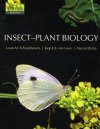Textbook
By: Louis M Schoonhoven, Joop JA Van Loon and Marcel Dicke
421 pages, 213 line illus, 11 halftones, 2pp colour plates
![Insect-Plant Biology Insect-Plant Biology]()
Click to have a closer look
About this book
Contents
Customer reviews
Related titles
About this book
New edition of this key text, first published by Chapman & Hall in 1997.
From the publisher's announcement:
Half of all insect species are dependent on living plant tissues, consuming about 10% of plant annual production in natural habitats and an even greater percentage in agricultural systems, despite sophisticated control measures. Plants possess defences that are effective against almost all herbivorous insect species. Host-plant specialization, observed in over 80% of these animals, appears to be an effective adaptation to breach these defence systems. The mechanisms underlying plant defence to invading herbivores on the one side, and insect adaptations to utilize plants for nutrition, defence and shelter on the other, are the main subjects of this book. For plants exposed to insect herbivores, these mechanisms include the activation of defence systems and the emission of chemical signals which may attract natural enemies of the invading herbivores and may even be exploited by neighbouring plants to induce an early defence. For insects, they include complex behavioural adaptations and their underlying sensory systems (with their implications for learning and nutritional plasticity), as well as the endocrinological aspects of life cycle synchronization with host-plant phenology.
Insect-Plant Biology discusses the operation of these mechanisms at the molecular and organismal levels and explicitly puts these in the context of both ecological interactions and evolutionary processes. In doing so, it uncovers the highly intricate antagonistic as well as mutualistic interactions that have evolved between plants and insects. The book concludes with a chapter on the application of our knowledge of insect-plant interactions to agricultural production.
This multidisciplinary approach will appeal to students in biology, agricultural entomology, ecology, and indeed anyone interested in the principles underlying the relationships between the two largest groups of organisms on earth: plants and insects.
Contents
1. Introduction; 2. Herbivorous insects: something for everyone; 3. Plant structure: the solidity of anti-herbivore protection; 4. Plant chemistry: endless variety; 5. Plants as insect food: not the ideal; 6. Host-plant selection: how to find a host plant; 7. Host-plant selection: when to accept a plant; 8. Host-plant selection: variation is the rule; 9. The endocrine system of herbivores listens to host-plant signals; 10. Ecology: living apart together; 11. Evolution: insects and plants forever in combat; 12. Insects and flowers: mutualism par excellence; 13. Insects and plants: how to apply our knowledge; Appendix A: Further reading; Appendix B: Structural formulae; Appendix C: Methodology; Taxonomic index; Author index; Subject index
Customer Reviews
Textbook
By: Louis M Schoonhoven, Joop JA Van Loon and Marcel Dicke
421 pages, 213 line illus, 11 halftones, 2pp colour plates
This is an outstanding reference to past and recent work on plant-insect interactions. Kailen Mooney, The Quarterly Review of Biology, Vol 82




































